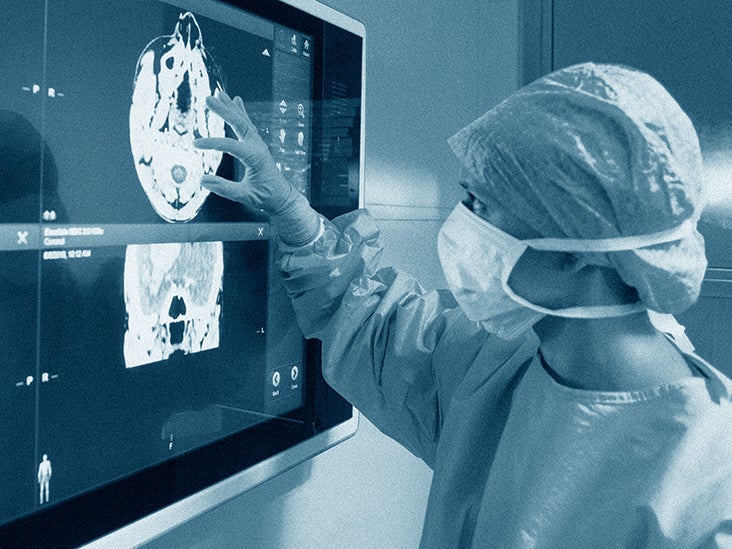
A recent three-pronged study concludes that SARS-CoV-2 may infect nerve cells and impede blood flow in the central nervous system.
COVID-19 continues to have devastating effects on the short- and long-term health of millions throughout the world.
Because SARS-CoV-2, the virus that causes the illness, is relatively new territory, researchers are still investigating how it functions within various organs.
A team of scientists, many from the Yale School of Medicine, in New Haven, CT, recently provided evidence that SARS-CoV-2 can directly infect cells in the central nervous system (CNS) and cause tissue damage.
The results appear in the Journal of Experimental Medicine.
SARS-CoV-2 infects lung tissue by binding to angiotensin converting enzyme 2 (ACE 2) receptors on the surfaces of cells. Once it binds to a cell, the virus can enter it and induce respiratory symptoms such as shortness of breath and a dry cough.
However, recent studies have shown that the virus can also infect cells in the CNS, which consists of the brain and spinal cord.
This helps explain the increasing number of patients with neurological symptoms, including dizziness, confusion, stroke, and coma.
The present study adds to earlier research by analyzing the mechanisms of nerve cell infection. To explore the extent and impact of the infection, the team used three different brain models: human brain organoids, genetically engineered mice, and autopsies of people with COVID-19 who had died.
The study first examined the potential for SARS-CoV-2 to infect the brain using human brain organoids — 3D models produced in a lab from stem cells of healthy individuals.
Scientists also used brain organoid models to analyze similar questions of neuronal infection during the Zika virus epidemic of 2015–2016.
In the present study, the organoids accumulated SARS-CoV-2-positive cells within specific brain regions, providing evidence that the virus can infect neurons and replicate itself.
The areas near these infected cells also signaled increased levels of cell death. However, it turned out that the majority of these dead cells had not been infected. Cells were susceptible to either infection or cell death, but rarely to both.
To investigate this further, the researchers compared the genes of infected cells with those of nearby uninfected cells. They found that infected cells demonstrated a heightened metabolism that allowed the virus to replicate more efficiently and potentially limit the oxygen supply of surrounding cells.
These findings suggest that the virus has the ability to alter cell metabolism to create an environment in which infected cells thrive and neighboring cells are unable to survive.
The organoid model also showed that the ACE2 receptor allowed the virus to enter brain cells, similarly to the way that this happens in the lungs. The result was surprising, as it had previously been unclear whether cells in the CNS produced ACE2 receptors.
When the researchers introduced antibodies to the organoid to block the protein, the virus was unable to bind to the protein, and the rates of cell infection decreased.
Next, the researchers used a mouse model to observe CNS infection within the context of an entire organism. To closely replicate the infection in humans, they genetically modified the mice to produce human ACE2 proteins.
After infecting the mice, the scientists detected high levels of infected nerve cells. These levels were associated with significant changes to blood vessels — changes that could disrupt the flow of oxygen to the brain.
The study also compared the effects of CNS infection and lung infection in mice and determined that CNS infection was significantly more lethal. Even with lower doses of the virus, neuronal infection caused weight loss and death in the mice.
Finally, the researchers examined the brain regions of three patients who had died from severe COVID-19 complications. All had experienced respiratory failure and been admitted to the intensive care unit.
Within the infected brain regions, there were indications of tissue damage and cell death in the form of ischemic infarcts — areas of dead tissue caused by a lack of blood flow.
These infarcts had resulted from several disruptions to oxygen and blood flow. They were similar to those that the researchers had observed in the brain organoid and mouse models, which had also shown evidence of oxygen deprivation.
“Altogether, our study provides [a] clear demonstration that neurons can become a target of SARS-CoV-2 infection, with devastating consequences of localized ischemia in the brain and cell death.”
– Co-senior author Dr. Kaya Bilguvar
Understanding which factors increase susceptibility to this infection will require more research, but the present study has provided insight into the more detailed mechanisms of the CNS in relation to COVID-19.
For live updates on the latest developments regarding the novel coronavirus and COVID-19, click here.
"may" - Google News
January 17, 2021 at 07:00PM
https://ift.tt/3nS8zvM
SARS-CoV-2 in neurons may damage brain tissue - Medical News Today
"may" - Google News
https://ift.tt/3foH8qu
https://ift.tt/2zNW3tO
Bagikan Berita Ini














0 Response to "SARS-CoV-2 in neurons may damage brain tissue - Medical News Today"
Post a Comment